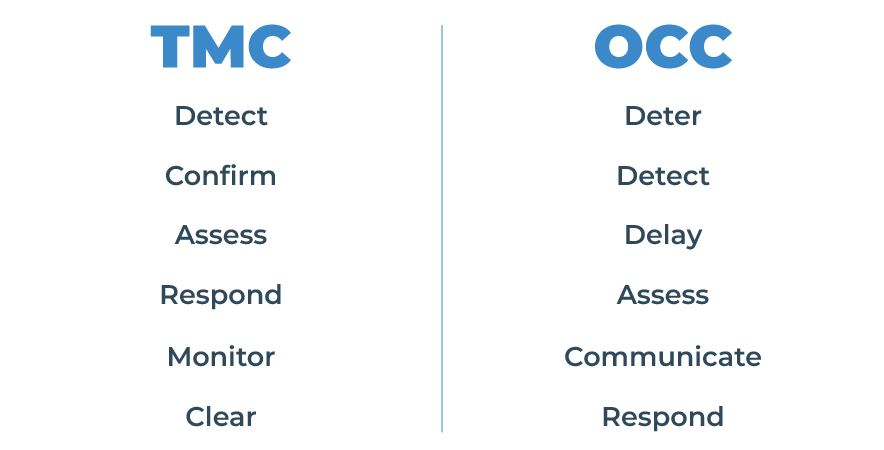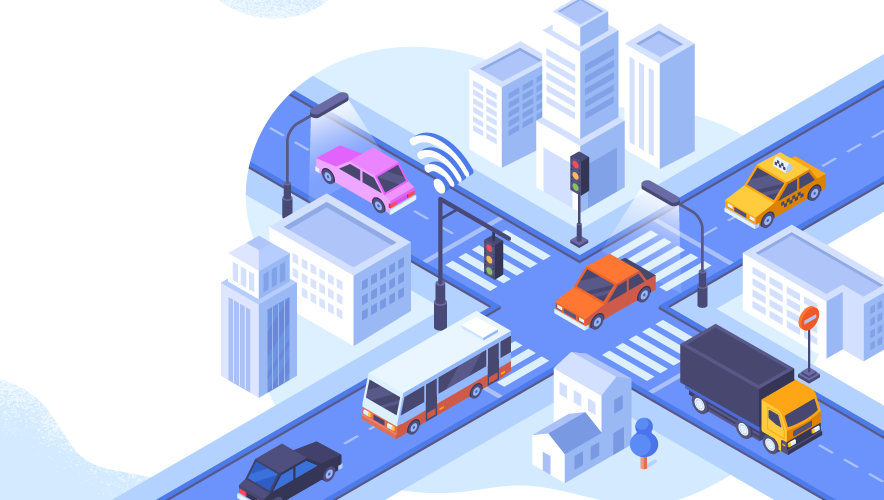Leveraging Transportation Data for Safety and Operations
Security and transportation can benefit from each other through closer collaboration and data access. Operations of a traffic management center (TMC) in transportation and an operations command center (OCC) for safety and security are very much alike. They use a similar standard structure for responding to incidents:

At the core of an advanced and innovative solution, the foundation of any operation is collecting key data to deploy the appropriate response and counter measures. It is important to understand how we can leverage transportation data sets to support our safety and security colleagues within a smart city.
Below are some examples of how data sets from a TMC, which are available to most cities, can be collected and disseminated to support the city’s safety, security, and overall operations. The assumption will be that every city, town, or incorporated/unincorporated area faces concerns of safety and security and is aiming to increase mobility to reduce congestion and improve environmental conditions.
Supporting Safety and Operations
Cities are a treasure trove of data, and that abundance will only increase with the deployment of fully functioning edge devices with artificial intelligence (AI) and machine learning (ML) capabilities.
The foundation of any operation is collecting key data to deploy the appropriate response and counter measures.
TMCs are vital to a city’s data exchange because operations have existing ethernet or passive optical network (PON) over fiber connecting cloud services and/or local server-based data. They ingest data from traffic signals; work zones; smart lighting; closed circuit television (CCTV) and license plate reader (LPR) cameras with AI/ML capabilities; cell phones; transit, fleet, and freight systems; and autonomous/connected vehicles (CAVs). CAVs will generate as much as 40 terabytes of data an hour, according to estimates from Original Equipment Manufacturers (OEMs) and Morgan Stanley.
From these basic sources, a city can determine: the number of vehicles on the roadway network, how efficiently the vehicles are moving (or not moving), basic safety messages from the CAVs (e.g. braking, acceleration, windshield wiper activation), the type/make/model and license plate of vehicles, the number and type of pedestrians on sidewalks and in crosswalks, the concentration of people and their activities and the location of transit, fleet, freight and transportation network companies (TNCs) like Uber and Lyft. These are data sets that we encounter every day that are an asset of a city.
This information, when leveraged, can provide a host of safety, security, and operational advantages for cities.
In a reactive model, the greatest capability of TMCs and OCCs is the ability to detect and reduce a delay or detect and respond to an incident. When performing investigations, such as on a traffic crash, obtaining accurate data quickly can aid in an investigation’s swift completion. In the proactive model of a Smart City, being able to predict incidents or identify situations that have a high probability to lead to an incident are foundational.
As we start to see more people returning to cities as the COVID-19 pandemic enters a new phase, take the example of visitors coming into a city for a holiday or a special event. Transportation data informs the city that there are more vehicles coming into and present in its center business district (CBD). This is denoted by sensor and third-party data (e.g. Google, Waze, Tom-Tom, HERE) illustrating an increase in vehicular traffic, and confirmed through CCTV cameras, without analytics, on approaches to the CBD.
Simultaneously, in this example, pedestrian CCTV cameras within the CBD, with analytics, show a 50 percent increase in foot traffic on sidewalks and crosswalks. Smart traffic signals confirm that throughput is less, due to the increased vehicular volumes and pedestrian activity. This combination is a lead indicator of three potential events: vehicular accidents (rear-end collisions), which could lead to road rage; petty theft, as pedestrians have closer encounters with one another; and large gathering disruptions that could lead to violence, robbery, and destruction of public property.
A proactive model allows two things to occur. First, the TMC can use the city streets efficiently by influencing traffic via traffic signal phase changes to allow for more traffic flow and platooning. TMC operators can inform third party applications of congestion, which would also allow for greater and safer pedestrian crossings. Second, the TMC can alert law enforcement of greater congestion and pedestrian activity so more officers and safety service personnel can be deployed to both deter criminal activity and respond rapidly to incidents that do occur.
In a reactive model, should there be an incident or crime, close collaboration between the TMC and law enforcement can help track vehicles or people involved in incidents, providing real-time data information, descriptions, and evidence to investigators. During investigations, offering law enforcement access to CCTV and LPR cameras and toll tags to track vehicle type, color, and movement will make investigations more efficient by providing concrete evidence.
There are a few U.S. cities that are starting to advance advanced analytics and predictive modeling, including Las Vegas, Nevada; Salt Lake City, Utah; and Detroit, Michigan. Many of these use specific software and algorithms, along with operational experience to deploy and hone these capabilities.
TMCs and transportation data can provide real-time support for proactive monitoring and historical support for investigations. By integrating seamless Smart City technologies, as described above, with proper broadband communications, TMCs and OCCs can proactively work together to reduce and deter crime, as well as provide access to information to support more efficient criminal investigations.
By Dan Corey, PE, vice president and national mobility technology director, STV. Corey has 25 years of experience in the intelligent transportation systems and technology space. He provides an operational-based viewpoint when deploying solutions, including various edge devices, as well as automated/connected vehicles. Connect with him at: [email protected]
© Dan Corey, PE - STV Incorporated
